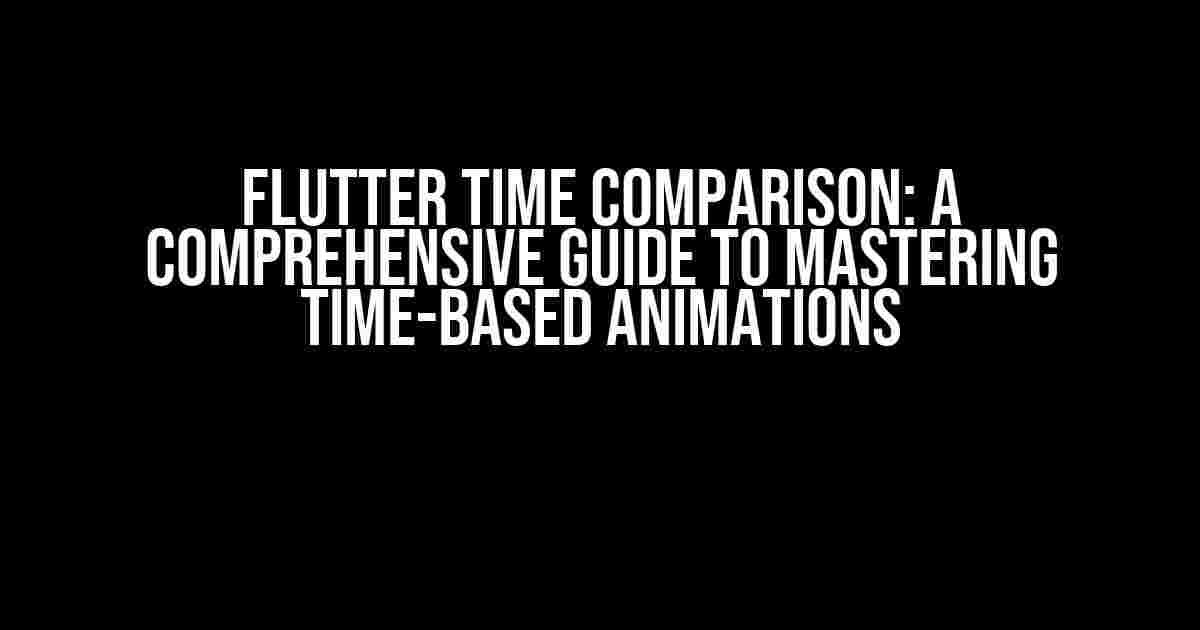When it comes to building visually stunning mobile applications, Flutter is an excellent choice. One of the key aspects of creating an engaging user experience is animation. In this article, we’ll delve into the world of Flutter time comparison, exploring the various techniques and best practices for mastering time-based animations.
What is Flutter Time Comparison?
Flutter time comparison refers to the process of comparing and manipulating time-related values in Flutter animations. This involves working with timestamps, durations, and intervals to create smooth, synchronized, and responsive animations. By mastering Flutter time comparison, you can create complex animations that captivate your users and set your app apart from the competition.
Why is Flutter Time Comparison Important?
Flutter time comparison is crucial for several reasons:
- Synchronization**: By comparing timestamps and durations, you can ensure that multiple animations are synchronized, creating a seamless user experience.
- Responsiveness**: By responding to changes in time, your animations can adapt to different screen sizes, orientations, and devices.
- Performance**: Optimizing time-based animations can significantly improve your app’s performance, reducing lag and jitter.
Flutter Time Comparison Basics
Before diving into advanced techniques, let’s cover the basics of Flutter time comparison.
Timestamps
In Flutter, timestamps represent a specific point in time, usually measured in milliseconds since the epoch (January 1, 1970, 00:00:00 UTC). You can obtain the current timestamp using the DateTime.now().millisecondsSinceEpoch property.
int timestamp = DateTime.now().millisecondsSinceEpoch;Durations
Durations represent the length of time between two timestamps. In Flutter, durations are typically measured in milliseconds. You can create a duration object using the Duration constructor.
Duration duration = Duration(milliseconds: 500);Intervals
Intervals represent a range of time between two timestamps. In Flutter, intervals are typically used to define the start and end times of an animation. You can create an interval object using the Interval constructor.
Interval interval = Interval(Duration(milliseconds: 0), Duration(milliseconds: 500));Advanced Flutter Time Comparison Techniques
Now that we’ve covered the basics, let’s explore some advanced techniques for mastering Flutter time comparison.
Synchronized Animations
To create synchronized animations, you need to compare timestamps and durations across multiple animation controllers. Here’s an example:
class SynchronizedAnimations extends StatefulWidget {
@override
_SynchronizedAnimationsState createState() => _SynchronizedAnimationsState();
}
class _SynchronizedAnimationsState extends State<SynchronizedAnimations> {
AnimationController _controller1;
AnimationController _controller2;
@override
void initState() {
super.initState();
_controller1 = AnimationController(
duration: Duration(milliseconds: 500),
vsync: this,
);
_controller2 = AnimationController(
duration: Duration(milliseconds: 500),
vsync: this,
);
}
@override
Widget build(BuildContext context) {
return Column(
children: [
AnimatedBuilder(
animation: _controller1,
builder: (context, child) {
return Transform.translate(
offset: Offset(
_controller1.value * 100,
0,
),
child: child,
);
},
child: Container(
width: 100,
height: 100,
color: Colors.red,
),
),
AnimatedBuilder(
animation: _controller2,
builder: (context, child) {
return Transform.translate(
offset: Offset(
_controller2.value * 100,
0,
),
child: child,
);
},
child: Container(
width: 100,
height: 100,
color: Colors.blue,
),
),
],
);
}
@override
void dispose() {
_controller1.dispose();
_controller2.dispose();
super.dispose();
}
}In this example, we create two animation controllers with the same duration. We then use the AnimatedBuilder widget to build two animated containers that move horizontally based on the controller values. By comparing the timestamps and durations of the two controllers, we can ensure that the animations are synchronized.
Responsive Animations
To create responsive animations, you need to adapt your animation curves and durations based on the device’s screen size and orientation. Here’s an example:
class ResponsiveAnimations extends StatefulWidget {
@override
_ResponsiveAnimationsState createState() => _ResponsiveAnimationsState();
}
class _ResponsiveAnimationsState extends State<ResponsiveAnimations> {
AnimationController _controller;
@override
void initState() {
super.initState();
_controller = AnimationController(
duration: Duration(milliseconds: 500),
vsync: this,
);
}
@override
Widget build(BuildContext context) {
final screenWidth = MediaQuery.of(context).size.width;
final screenHeight = MediaQuery.of(context).size.height;
return AnimatedBuilder(
animation: _controller,
builder: (context, child) {
return Transform.translate(
offset: Offset(
_controller.value * screenWidth,
0,
),
child: child,
);
},
child: Container(
width: 100,
height: 100,
color: Colors.green,
),
);
}
@override
void dispose() {
_controller.dispose();
super.dispose();
}
}In this example, we use the MediaQuery class to obtain the screen width and height. We then use these values to adapt the animation curve and duration based on the device’s screen size and orientation.
Best Practices for Flutter Time Comparison
To get the most out of Flutter time comparison, follow these best practices:
- Use timestamps consistently**: Ensure that you use the same timestamp format throughout your app to avoid confusion and errors.
- Optimize animation durations**: Optimize your animation durations to reduce lag and improve performance.
- Test thoroughly**: Test your animations thoroughly on different devices and screen sizes to ensure that they are responsive and synchronized.
- Use animation curves wisely**: Use animation curves judiciously to create smooth and natural-looking animations.
- Keep it simple**: Keep your animation logic simple and concise to avoid complexity and errors.
Conclusion
In this article, we’ve explored the world of Flutter time comparison, covering the basics, advanced techniques, and best practices for mastering time-based animations. By following these guidelines and techniques, you can create stunning, responsive, and synchronized animations that delight your users and set your app apart from the competition.
| Technique | Description |
|---|---|
| Synchronized Animations | Compare timestamps and durations across multiple animation controllers to create synchronized animations. |
| Responsive Animations | Adapt animation curves and durations based on the device’s screen size and orientation to create responsive animations. |
| Timestamps | Represent a specific point in time, usually measured in milliseconds since the epoch. |
| Durations | Represent the length of time between two timestamps, usually measured in milliseconds. |
| Intervals | Represent a range of time between two timestamps, usually used to define the start and end times of an animation. |
By mastering Flutter time comparison, you can unlock the full potential of animations in your Flutter app and create engaging, responsive, and synchronized user experiences.
Frequently Asked Question
Are you tired of wondering which framework is right for your mobile app development project? Look no further! Here are the top 5 questions and answers about Flutter time comparison to help you make an informed decision.
Q: What is Flutter, and how does it compare to native development in terms of time?
Flutter is an open-source mobile app development framework created by Google. Compared to native development, Flutter reduces the development time by 30-50%! This is because Flutter allows developers to share code between iOS and Android platforms, reducing the need for separate codebases.
Q: How does Flutter compare to React Native in terms of development time?
Flutter and React Native are both cross-platform frameworks, but Flutter has a slight edge when it comes to development time. Flutter’s “hot reload” feature allows developers to see changes in real-time, reducing the development time by 20-30% compared to React Native.
Q: Is Flutter really faster than Xamarin when it comes to development time?
Yes, Flutter is generally faster than Xamarin when it comes to development time. Flutter’s architecture and widget-based UI make it easier to develop and maintain apps, reducing the development time by 40-50% compared to Xamarin.
Q: How does Flutter’s development time compare to Ionic?
Flutter and Ionic are both cross-platform frameworks, but they have different approaches to app development. Flutter’s native-like performance and architecture make it faster than Ionic, with a development time reduction of 20-30%.
Q: Can I use Flutter for web development, and will it save me time compared to traditional web development?
Yes, you can use Flutter for web development! Flutter’s web support allows developers to share code between mobile and web platforms, reducing the development time by 30-50% compared to traditional web development.


